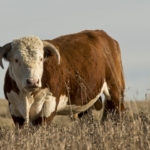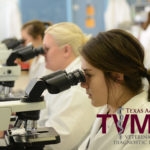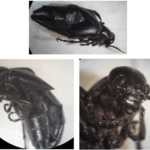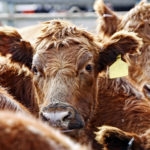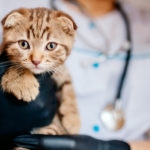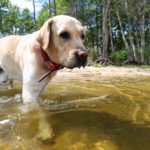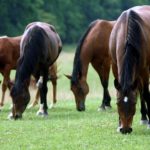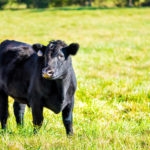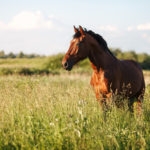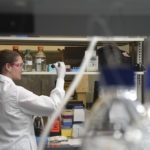Hepatozoonosis in a dog Sarah Eide and Julie Piccione, DVM, MS, DACVP An 11-month-old Bloodhound dog presented to an east Texas veterinary clinic with a 2-week history of lethargy, painfulness, and losing muscle mass. Vital signs included a … [Read more...] about Hepatozoonosis in a dog
college station
Pathologic diagnosis of coccidiosis in goats
Pathologic diagnosis of coccidiosis in goats Kellie Richardson and Erin Edwards, DVM, MS, DACVP Coccidia are single-celled parasites that are common in many species, including goats. Diagnosis of coccidiosis is most commonly achieved through … [Read more...] about Pathologic diagnosis of coccidiosis in goats
In-Pouch vs PBS for Trichomonas testing in bulls
In-Pouch vs PBS for trichomonas testing in bulls Guy Sheppard, DVM Over two years ago, the Texas Animal Health Commission (TAHC) approved the direct smegma sample submitted in PBS solution as an acceptable testing method for Trichomoniasis … [Read more...] about In-Pouch vs PBS for Trichomonas testing in bulls
Reference intervals updated for several caprine and ovine panels
In an effort to always provide optimum laboratory results, the Texas A&M Veterinary Medical Diagnostic Laboratory (TVMDL) clinical pathology laboratories recently completed a large study to update the reference intervals in several panels for … [Read more...] about Reference intervals updated for several caprine and ovine panels
Ocular coccidiomycosis in a puppy
Ocular coccidiomycosis in a puppy Erin Edwards, DVM, MS, DACVP Last summer, ocular coccidiomycosis was diagnosed via histopathology in a 12-week-old Great Pyrenees puppy. The puppy was from Brewster county in West Texas. This puppy was clinically … [Read more...] about Ocular coccidiomycosis in a puppy
Cushing’s Disease Diagnosed with Low Dose Dexamethasone Suppression Test
Cushing’s Disease Diagnosed with Low Dose Dexamethasone Suppression Test Julie Piccione, DVM, MS, DACVP A 13-year-old female spayed Beagle was presented to its veterinarian for increased urination. On physical exam, the veterinarian noted a … [Read more...] about Cushing’s Disease Diagnosed with Low Dose Dexamethasone Suppression Test
Quantitating Cantharidin levels in a blister beetle
Quantitating Cantharidin levels in a blister beetle By Cat Barr, PhD, DABT In January, an animal owner in northwestern Washington State contacted the Texas A&M Veterinary Medical Diagnostic Laboratory (TVMDL) regarding possible blister … [Read more...] about Quantitating Cantharidin levels in a blister beetle
Johne’s Disease: How are cattle affected?
Johne’s Disease: How are cattle affected? Guy Sheppard, DVM The Texas A&M Veterinary Medical Diagnostic Laboratory (TVMDL) has seen quite a few cattle testing positive for Johne’s Disease in the last several months. Clinically affected cattle … [Read more...] about Johne’s Disease: How are cattle affected?
Suspected Anticoagulant Bait Confirmed to be Bromethalin
Suspected Anticoagulant Bait Confirmed to be Bromethalin Amy Phillips, Analytical Chemistry Technician and Travis Mays, MS, PhD, Analytical Chemistry Section Head A male kitten was rescued by animal control and taken to a veterinary clinic for … [Read more...] about Suspected Anticoagulant Bait Confirmed to be Bromethalin
Horse Diagnosed with Equine Botryomycosis
Horse Diagnosed with Equine Botryomycosis Kayla Tomaso and Erin Edwards, DVM, MS, DACVP Tissue samples from two ear masses on a 3-year-old American Quarter Horse were submitted to the Texas A&M Veterinary Diagnostic Lab (TVMDL) in College … [Read more...] about Horse Diagnosed with Equine Botryomycosis
Chromatophoromas in lacertids
Chromatophoromas in lacertids By Gaya Balamayooran, DVM, PhD, DACVP and Josué Diaz-Delgado, DVM, MS, PhD, DACVP A 76 gram, 9-year-old female knight anole (Anolis equestris) lizard from a zoological collection was euthanized due to poor prognosis … [Read more...] about Chromatophoromas in lacertids
Cyanobacteria: No winter break this year
Cyanobacteria: No winter break this year By Cat Barr, PhD, DABT Blue-green algae (cyanobacteria) have barely taken a break this winter. The Texas A&M Veterinary Medical Diagnostic Laboratory (TVMDL) has already had several positive samples … [Read more...] about Cyanobacteria: No winter break this year
Segmental analysis of hair for drug detection in racing horses
Segmental analysis of hair for drug detection in racing horses Travis Mays, MS, PhD The Texas A&M Veterinary Medical Diagnostic Laboratory’s (TVMDL) drug testing laboratory offers a screen for the detection of beta-adrenergic agonist drugs, … [Read more...] about Segmental analysis of hair for drug detection in racing horses
Malignant Catarrhal Fever in a 1-year-old heifer
Malignant Catarrhal Fever in a 1-year-old heifer By R. Gayman Helman, DVM, PhD, Guy Sheppard, DVM, and Meagan Schroeder, PhD A 1-year-old heifer became weak and isolated herself. Three days later, the heifer was examined by the submitting … [Read more...] about Malignant Catarrhal Fever in a 1-year-old heifer
Diagnostic guidance: Cantharidin poisoning in horses
When horses ingest the cantharidin toxin through hay or alfalfa contaminated with “blister” beetles, the outcome is often fatal. Toxicosis occurs rapidly; as little as four grams of dried beetles may contain fatal levels of … [Read more...] about Diagnostic guidance: Cantharidin poisoning in horses
Calcinosis Circumscripta
Calcinosis Circumscripta Judith Akins, DVM, MS Slides from an aspirate of a mass on the left elbow of a two-year-old, intact male German Shepherd dog were submitted to the Texas A&M Veterinary Medical Diagnostic Laboratory (TVMDL) for … [Read more...] about Calcinosis Circumscripta
Dogs will eat anything, won’t they?
Dogs will eat anything, won’t they? Cat Barr, PhD, DABT Four dogs were brought to a veterinary clinic when one had been seizing for several hours and the other three had begun to tremble. All four dogs had reportedly been running loose in a rural … [Read more...] about Dogs will eat anything, won’t they?
Necropsy of rare bovine conjoined twins
Necropsy of rare bovine conjoined twins By Erin Edwards, DVM, MS, DACVP and Gaya Balamayooran, DVM, PhD, DACVP Recently, bovine conjoined twin calves were submitted to the Texas A&M Veterinary Medical Diagnostic Laboratory (TVMDL). Both the … [Read more...] about Necropsy of rare bovine conjoined twins
Prepare your horses for spring: Vaccinate for West Nile virus and Eastern Equine Encephalitis virus
Last year, the Texas A&M Veterinary Medical Diagnostic Laboratory (TVMDL), documented fewer cases of West Nile virus than in previous years. The number of positive cases of West Nile virus in horses seen at TVMDL fluctuates from year to year, … [Read more...] about Prepare your horses for spring: Vaccinate for West Nile virus and Eastern Equine Encephalitis virus
Drug screen for beta-agonists in hair and wool for livestock species added to TVMDL test catalog
The Texas A&M Veterinary Medical Diagnostic Laboratory (TVMDL) is pleased to announce the addition of a drug screen for beta-agonists in hair and wool for livestock species. Similar to retinal tissue, hair and wool have been shown to retain … [Read more...] about Drug screen for beta-agonists in hair and wool for livestock species added to TVMDL test catalog
Neospora caninum Abortion in Cattle
Neospora caninum Abortion in Cattle Guy Sheppard, DVM Neospora caninum is a protozoal organism that is associated with abortion in cattle and the birth of weak calves. Dogs are the definitive hosts for this organism, and the organism is spread … [Read more...] about Neospora caninum Abortion in Cattle
Histopathologic Diagnosis of Feline Herpesvirus
Histopathologic Diagnosis of Feline Herpesvirus Erin Edwards, DVM, MS, DACVP and Jay Hoffman, DVM, PhD, DACVP Feline herpesvirus is a highly transmissible, viral disease that is very common in cats. This disease is also known as feline viral … [Read more...] about Histopathologic Diagnosis of Feline Herpesvirus
Possible Wilted Maple Poisoning in Mare
Possible Wilted Maple Poisoning in Mare Cat Barr, PhD, DABT A 7-year-old pastured mare suffered an acute onset of hemolytic anemia and hematuria. The blood drawn for analysis was hemolyzed and dark. The mare died about three hours after … [Read more...] about Possible Wilted Maple Poisoning in Mare
Canine Coccidiosis
Canine Coccidiosis Jai Guha, Mindy Borst, LVT, and Julie Piccione, DVM, MS, DACVP An 11-year-old Corgi mix was presented to the veterinarian with intermittent diarrhea and inappetence. History noted the dog had clinical signs of gastrointestinal … [Read more...] about Canine Coccidiosis
Acute Toxoplasma gondii Infection Confirmed in a Canine
Acute Toxoplasma gondii Infection Confirmed in a Canine Cheryl Maguire, DVM An adult, mixed-breed dog was presented to their veterinarian for progressive lethargy, fever, and abdominal distension. The dog had recently started treatment with … [Read more...] about Acute Toxoplasma gondii Infection Confirmed in a Canine


